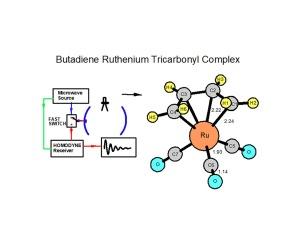η4-丁二烯三羰基钌的微波光谱和分子结构计算
IF 1.3
4区 物理与天体物理
Q4 PHYSICS, ATOMIC, MOLECULAR & CHEMICAL
引用次数: 0
摘要
使用 Flygare-Balle 型脉冲光束傅立叶变换微波(FTMW)光谱仪在 5-15 GHz 频率范围内测量了η4-丁二烯三羰基钌的微波光谱。102Ru 同素异形体的旋转常数被确定为以下值:A = 932.20099(42),B = 858.03248(47),C = 831.35161(37)兆赫。离心畸变常数 dJ 为 0.0862(29)千赫。测量了 22 个 a-偶极和 4 个 c-偶极跃迁。利用 DFT 和 MP2 方法以及不同的基集(其中一些包括核势能 (ECP))对 G16 进行了广泛的高级计算。最佳结构是使用 B3LYP/def2-QZVPP 高斯 16 计算得出的,其中包括核心势(ECP)。根据最佳 ECP 结构进行了广泛的全电子计算,以预测 101Ru 和 99Ru 的四极耦合强度。对 101Ru 和 99Ru 的四极超正弦结构分裂进行了测量。测量了 101Ru 核四极的超正弦结构分裂,得出的数值为 1.5χaa = 98.12(17) MHz 和 0.25(χbb-χcc) = 36.059(30)。99Ru 四极耦合的超正弦结构分裂测量值为 1.5χaa = 16.99(77) MHz 和 0.25(χbb-χcc) = 6.23(32)。这些数值与一些全电子计算结果相当吻合。本文章由计算机程序翻译,如有差异,请以英文原文为准。

Microwave spectrum and molecular structure calculations for η4-butadiene ruthenium tricarbonyl
The microwave spectrum of η4-butadiene ruthenium tricarbonyl was measured in the 5–15 GHz frequency range using a Flygare-Balle type pulsed beam Fourier transform microwave (FTMW) spectrometer. The rotational constants for the 102Ru isotopologue were determined to have the following values: A = 932.20099(42), B = 858.03248(47) and C = 831.35161(37) MHz. The centrifugal distortion constant dJ is 0.0862(29)kHz. 22 a-dipole and 4c-dipole transitions were measured. Extensive high-level G16 calculations were made using DFT and MP2 methods with various basis sets, some including core-potentials (ECP). The best structure was calculated with Gaussian 16 using B3LYP/def2-QZVPP, which includes a core potential (ECP). Extensive all-electron calculations were made based on the best ECP structure to predict 101Ru and 99Ru quadrupole coupling strengths. Quadrupole hyperfine structure splittings were measured for both 101Ru and 99Ru. The hyperfine structure splittings for the 101Ru nuclear quadrupole were measured, yielding the values of 1.5χaa = 98.12(17) MHz and 0.25(χbb-χcc) = 36.059(30). Measured hyperfine structure splittings for 99Ru quadrupole coupling yielded the values of 1.5χaa = 16.99(77) MHz and 0.25(χbb-χcc) = 6.23(32). These values are in reasonable agreement with some of the all-electron calculations.
求助全文
通过发布文献求助,成功后即可免费获取论文全文。
去求助
来源期刊
CiteScore
2.70
自引率
21.40%
发文量
94
审稿时长
29 days
期刊介绍:
The Journal of Molecular Spectroscopy presents experimental and theoretical articles on all subjects relevant to molecular spectroscopy and its modern applications. An international medium for the publication of some of the most significant research in the field, the Journal of Molecular Spectroscopy is an invaluable resource for astrophysicists, chemists, physicists, engineers, and others involved in molecular spectroscopy research and practice.

 求助内容:
求助内容: 应助结果提醒方式:
应助结果提醒方式:


